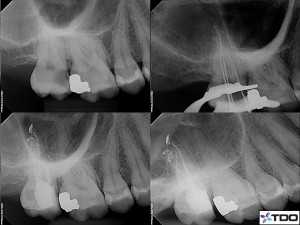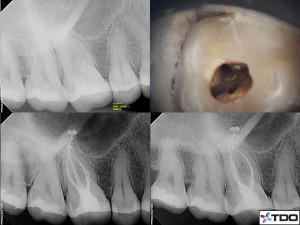I started this blog with the intention of sharing my experiences and ideas as an endodontist. I want to take this opportunity to dissect a few cases over the next few weeks. My hope is that it will give some clarity as to my thought process, as well as the rationale for my treatment decisions.
In 1965, a researcher by the name of Kakehashi confirmed what was first proposed by Miller three quarters of a century earlier. Using two populations of rats, one that was infected by bacteria and another that was raised germ-free, a difference was noted secondary to pulpal injury. In the absence of bacteria, no matter how severe the pulpal injury was, the pulp was able to heal. However, when bacteria were present, the outcome was always pulpal necrosis and secondary to that, apical periodontitis.
However, when treating our patients, we are working in an environment where bacteria thrive. The mouth is a warm, moist environment that is constantly inundated with fuels that bacteria love. So how can we eliminate them from the equation? The first thing we can do is isolate the tooth we are going to work on.
My preferred method of isolation is the rubber dam. I have spoken to colleagues of mine who dislike the rubber dam and prefer the Isolite or other methods of isolation. There is no wiggle room on the use of the rubber dam in my practice. Not only does it provide protection medicolegally, but it gives me peace of mind that my patients will be safe and that the tooth I am working on can be effectively isolated from the oral environment.
There are a wide number of clinically available dams, with frame attached, unattached, latex, nonlatex, it runs the gamut. I prefer a nonlatex dam as we have no latex in our office. The reason for this is that we have patients who have latex allergy. In addition, we are exposed to the allergens in our office daily. Eliminating the latex allergen from my office has been good for me and my staff as well.
The next adjunct is a rubber dam clamp. Commercially available in a number of different sizes and shapes, a wide variety has proven useful to me. I also will often use preoperative buildups, floss, wedges, automatrix bands, copper bands and gingival barrier to ensure that I have a fluid tight seal on the tooth before starting. It’s too laborious to go into exactly how I use all of them in great detail. However, if you are committed to achieving ideal isolation on an endodontic case most if not all of the supplies needed to do so should be readily available in any dental office.
The one thing that can be done easily and has virtually zero learning curve is the use of a gingival barrier. These agents are readily available from any dental supplier. They are a light cured flowable agent that helps fill in the gaps that may exist after placing a rubber dam and clamp. I will often place the dam and any additional adjuncts I may need like floss or wedges. Then I will place a bend on a saliva ejector and place it in close proximity to the clamp underneath the dam. That helps pull away excess fluid. I’ll then place the gingival barrier with the ejector in place and the pressure from it will help pull gingival barrier under the margins of the rubber dam to seal it. Light cure, and I’m pretty sure you’ll have a fluid tight seal. Not sure? Grab your air/water and shoot some water in it. Wait 10-20 seconds and check the fluid level. You don’t want saliva getting into the field, and you don’t want people tasting the medicaments we are using during endodontic procedures. If you haven’t tasted any of them, you should. Not good.
Here are two cases recently treated in my practice.
Although the radiographic outcomes are acceptable, both of these referring dentists should be commended. I’ll elaborate on that during the next installment.


Excellent blog Dave. You’re so articulate. I love it. I finally got around to joining TDO as per your suggestion. I should have done that 9 months ago. See you in the forums.
Tyler
Thanks a bunch Tyler. It’s a lot of fun to look at the things I do every day in my practice and try to distill something from it that I can share. You’re going to love TDO. I’ll see you in the forums for sure.